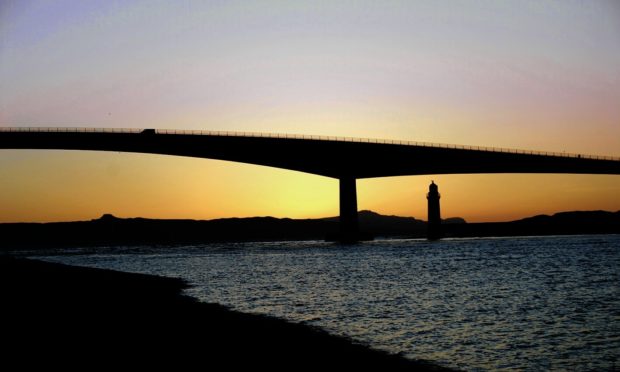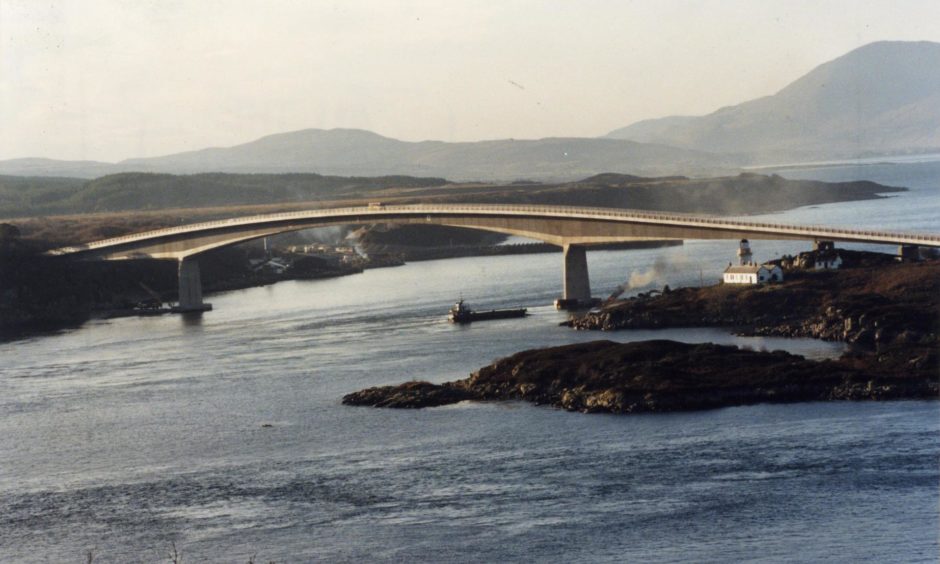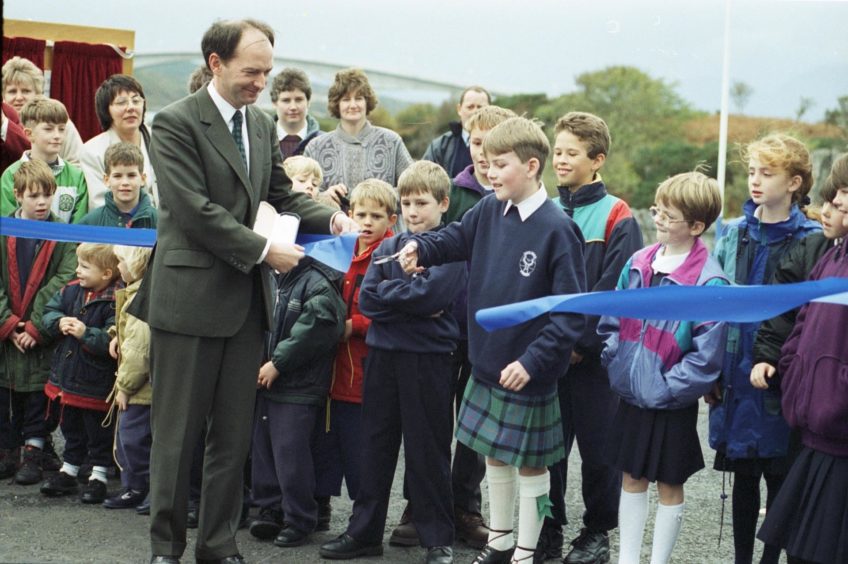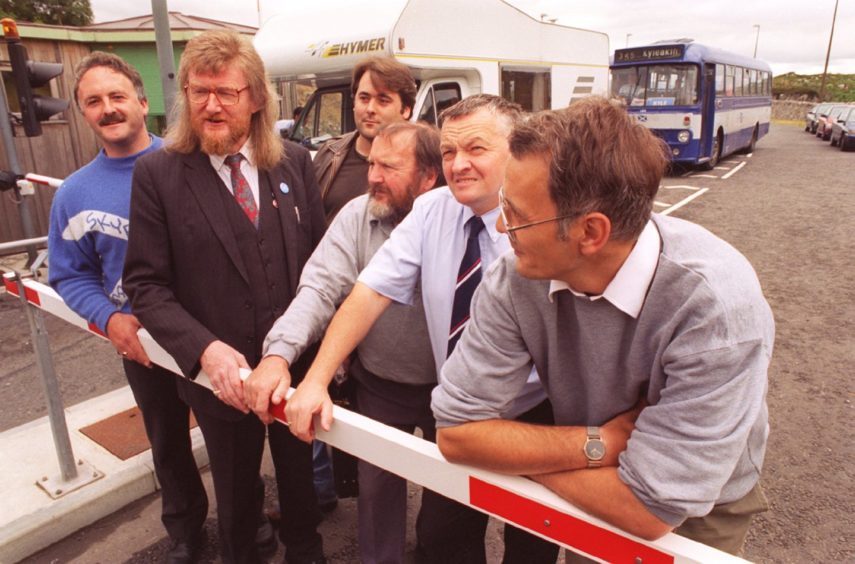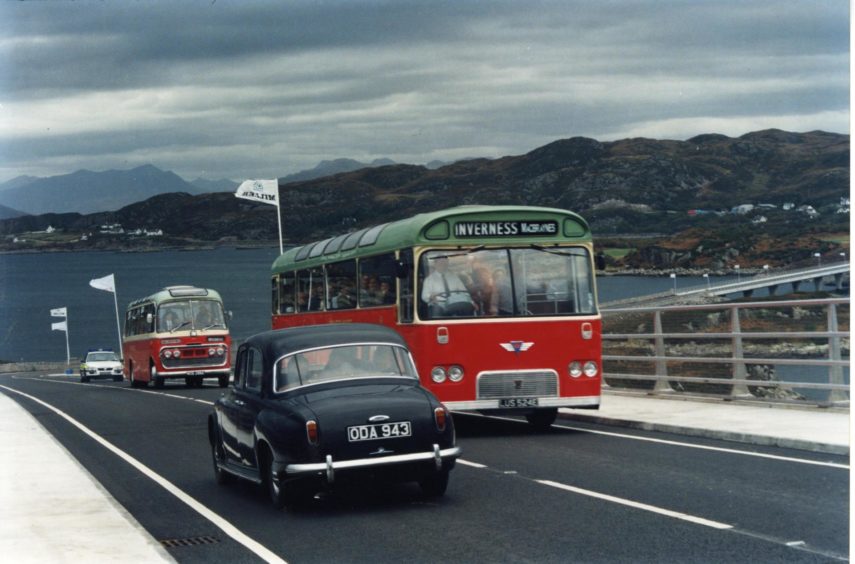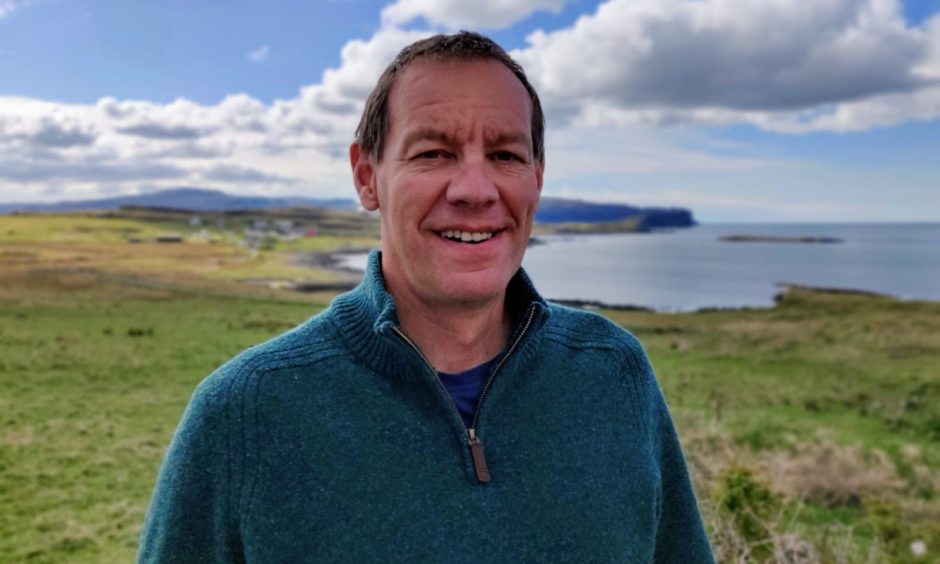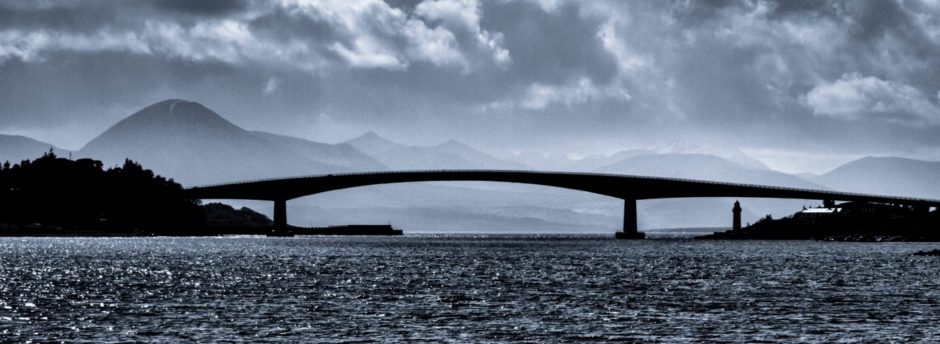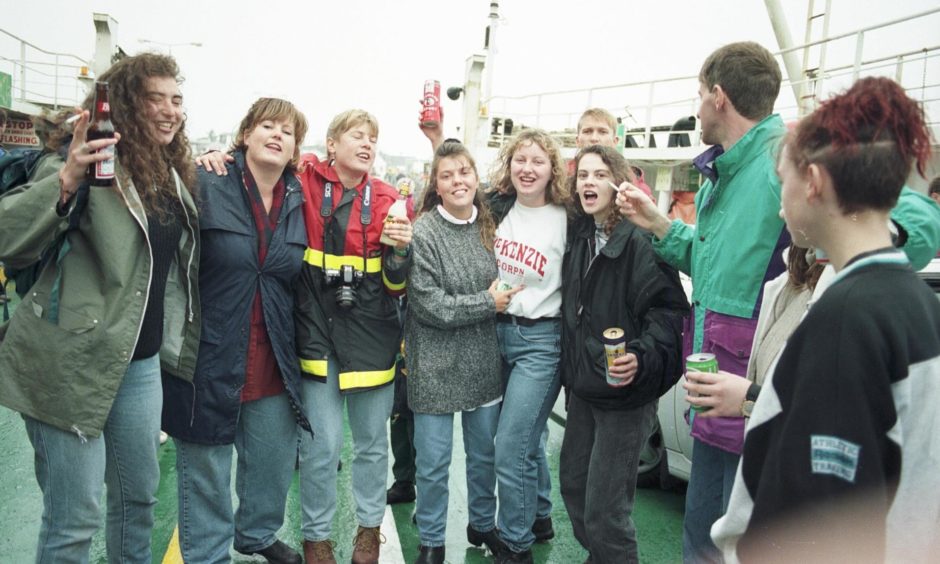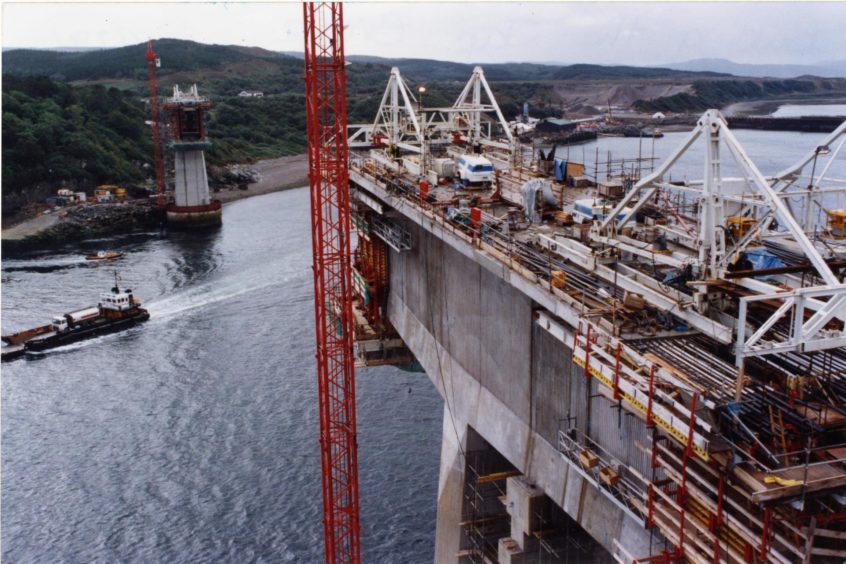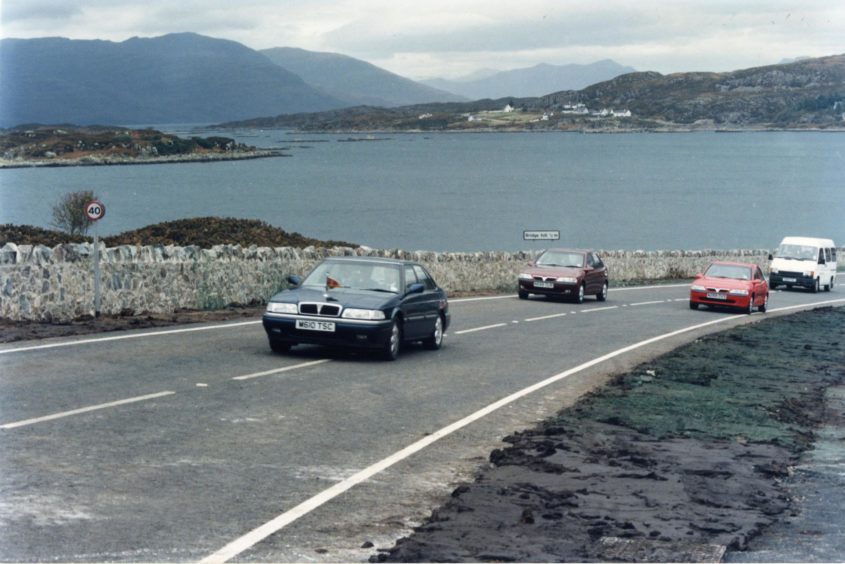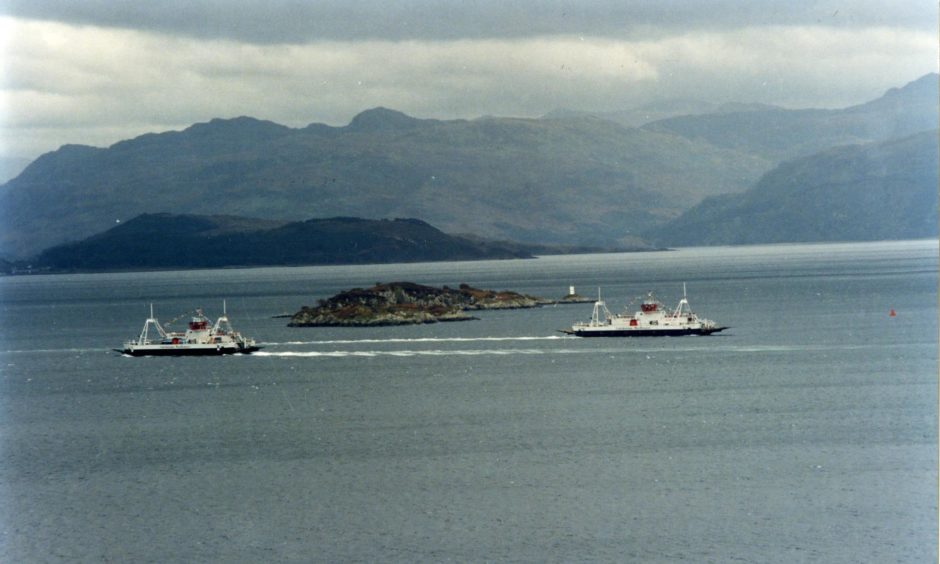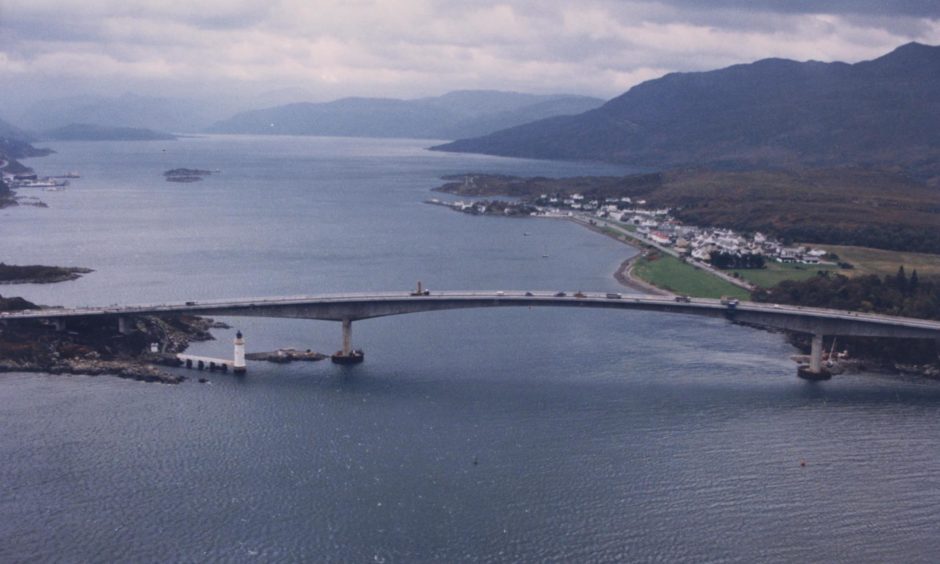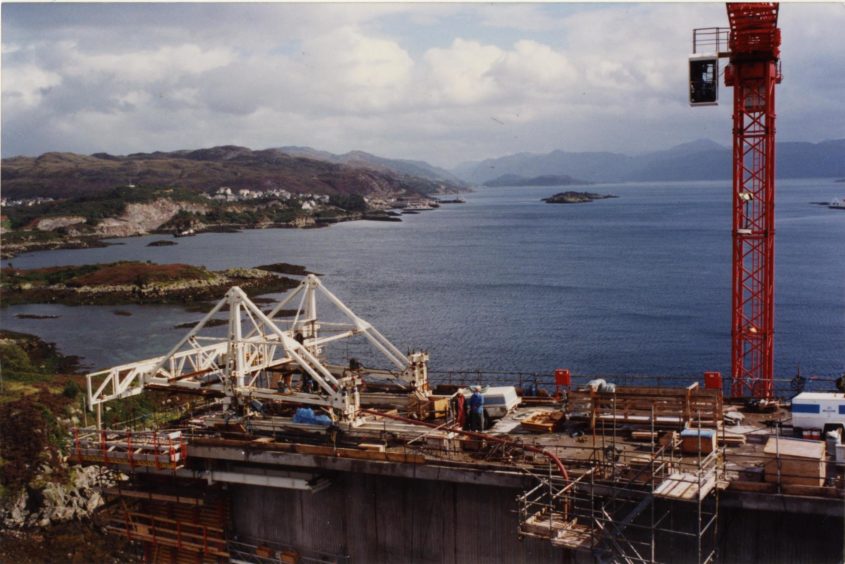When the Skye Bridge opened 25 years ago today – on October 16 1995 – it was mired in controversy. Gayle Ritchie takes up the story.
The distinctive arc of the Skye Bridge, silhouetted against the sky and ringed by wild mountain scenery, is an impressive sight.
There’s little doubt that the bridge has made the magical Hebridean island much more accessible – it’s one of the most visited places in Scotland.
But crossing the road bridge by car, bike or on foot as opposed to making the journey by sea doesn’t quite have the same sense of romantic mysticism about it.
Nevertheless, the Skye Bridge is a striking gateway to the enchanting, rugged island.
When it opened 25 years ago today – at 11am on October 16 1995 – the bridge was embroiled in controversy.
Islanders had been calling for a road bridge from the mainland for decades as growing visitor numbers were putting a strain on ferry services.
They were also keen to have 24/7 access to the mainland, plus they hoped a bridge would attract more tourists, thereby boosting the island’s economy.
When they finally got their wish, there was a catch, and a big one – they had to pay through the nose each time they wanted to cross the bridge.
The bridge, which had cost £39 million to construct, was officially opened by Secretary of State for Scotland Michael Forsyth, with local school children helping to cut the ribbon.
The ferry services ceased, and the shiny new bridge and the Mallaig to Armadale ferry were the only year-round connections to the mainland. It was an emotional time – the end of an era.
The tolls were introduced at midnight, sparking outrage. Car drivers were charged up to £5.20 each way – or £11.40 for a return journey.
When people compared this with the Forth Road Bridge, which was only 40p to cross, tempers flared, even more so when protesters said the charge made it the “most expensive road in Europe”.
When the first cars arrived at the toll booth, a storm was raging, but the uproar from the community was only beginning to stir.
The drivers refused to pay the extortionate toll, and then, walking through the rain came a pipe band, walking across the bridge, followed by dozens of cars.
Driver after driver refused to pay the toll. Those who refused to pay were charged and reported to the procurator fiscal.
From driving flocks of sheep across the bridge to paying the toll in pennies, the protesters sought to create drama as well as a disturbance.
Their actions quickly gained international media attention and sparked political debate.
A protest group, Skye and Kyle Against Tolls (Skat) was set up while veteran campaigner Robbie the Pict became famous in Scotland as he sought to prove the tolls were imposed unlawfully.
Among the hundreds of non-payment cases, 130 people ended up with criminal convictions and one man – Skat secretary Andy Anderson – served 11 days in prison.
Even today, in 2020, campaigners are fighting to repeal those convictions.
Nine years after its introduction, the toll was abolished on December 21 2004 after the Scottish Government bought the bridge from its US-based owners at a cost of £27 million.
By that time, the toll had raked in a staggering £33.3 million.
In its first year, 612,00 vehicles crossed the Skye Bridge – a third more than the ferry’s official numbers.
The numbers have been rising ever since. Transport Scotland data show nearly 5,000 journeys over the crossing were made each day in 2019.
Bridge benefits
Skye is one of the most visited places in Scotland, drawn by its stunning mountain scenery, mils of dramatic coastline and captivating history.
After quarter of a century, the bridge seems to have been embraced on the whole by locals on both sides of the water. Most agree it has brought many benefit to local communities over the years.
The ability to get on and off the island – free of charge – 24 hours a day means emergency services can respond quickly to call-outs and ferries never need to be summoned in the middle of the night.
And while ferries could be cancelled when storms hit, the bridge is much more robust.
The bridge has also made the mainland more accessible for islanders – it’s easy for them to take a trip to Inverness for a meeting, a bit of shopping or to catch a gig.
And it’s meant people have more choice about where they live in relation to where they work.
Welcome addition
Dave Till, the general manager of Skyeskyns tannery, shop and visitor experience in Waternish, says the bridge has been a “welcome addition”.
His first visits to Skye were as a climber and walker in the late ’70s and early ’80s before he settled there.
Keen to take on some of the island’s most challenging summits, Dave recalls rushing from the hills to catch the ferry.
“These trips were always punctuated with a dash for the ferry on the way up or on the way off the island to squeeze that extra bit of time out of the day on the hills,” he recalls.
“The bridge was a welcome addition and made the trip from the my home south of the border less stressful knowing that I wouldn’t miss the last ferry.
“It also meant that the last day on the hills, which was inevitably the best day of the trip, could be savoured rather than it being a race against the clock and a hectic drive to the ferry.”
Dave, who is chair of tourism management organisation Skye Connect, noticed the biggest difference in the island’s accessibility when the bridge became toll-free.
“This removed the psychological barrier from the trip to Skye and began to make it a more popular destination,” he muses.
“Skye has benefited from this increased connectivity not only through the bridge but the better roads connecting the bridge to the south and east in a more vibrant economy. There’s also easier access for residents to the amenities of Inverness.
“We think nothing of heading to the theatre, the panto or a show at Eden Court and arriving back in the early hours, a trip that would have taken two days in the days of the ferry.”
Dave says his business witnessed a “noticeable jump” in visitor numbers in the years following the opening of the bridge and removal of tolls.
Mixed feelings
Skye councillor Calum MacLeod worked on the ferries, ticketing traffic, while the bridge was being constructed.
“The gap between Skye and the mainland got narrower as the days went by,” he recalls.
Councillor MacLeod says there were “mixed feelings” about the loss of the ferries.
“They evoke a lot of nostalgia in this part of the world and there were a lot of men, around 50, employed on them and who had put their lives into the ferries.
“Those who lost their jobs with the bridge either had to find other jobs or move away.”
Fears were raised about how the bustling communities of Kyle of Lochalsh on the mainland and Kyleakin on Skye would fare with the bridge.
“These had virtually guaranteed footfall with the ferries and some people feared the bridge would bypass Kyleakin leaving it to wither on the vine,” says Councillor MacLeod.
“However, Kyleakin has fared better than envisaged. Kyle of Lochalsh, however, is more of a corridor and hasn’t done so well.”
The loss of the ferries has seen the loss of community to a degree, believes Councillor MacLeod.
“The ferries were a good, cohesive way of bringing the two communities together.
“Everyone had to get on deck and there was great interaction between people.
“Now, with cars driving over the bridge, that element of community, of catching up with neighbours, has gone. And that’s quite sad.”
But Councillor MacLeod understands Skye needed the road bridge.
“The ferries had been in service for 20-odd years and were small capacity.
“The volume of traffic even then coming to Skye was quite big, and it was getting bigger.
“The ferries couldn’t cope. The queues were so long and one chap, a shellfish exporter, lamented he’d sit longer queuing to get on the ferry than to get across the Channel!
“So, yes, some people were desperate for a bridge – they couldn’t get it quick enough.
“There was a lot of jubilation about the bridge making things more accessible, although the tolls took the shine off it.
“But largely speaking, people were happy with the idea of a fixed link.”
Acceptance
Born and brought up in Kyleakin, Caroline Clouston has seen many changes over the years.
Her family had owned the general store at the ferry terminal in Kyleakin since 1930.
This closed, along with several businesses in Kyle of Lochalsh, after the bridge was built.
Where traffic had previously stopped to wait for ferries in both communities, it no longer had to – and this meant people no longer bothered using the local facilities.
Initially, Caroline was not in favour of the Skye Bridge, regarding it as a blot on the landscape – an ugly concrete lump which ruined the area’s beauty.
“Looking back, I, like most of the villagers, did not welcome change,” she reflects.
“I didn’t like the bridge visually and saw it as a mass of concrete which destroyed the views from Kyleakin beyond the lighthouse to the Inner Sound, Raasay and as far as the Storr.
“The bridge meant the village being bypassed, which wasn’t good for businesses, and it meant the loss of the ferry men’s jobs.
“As all traffic went through the village, it was a very busy place.”
There was certainly a sense of loss as the ferry stopped the day the bridge opened to traffic and Kyleakin as we knew it changed for ever.”
Caroline Clouston
Caroline also feared the link between the communities would be severed with the loss of the ferries.
“It was so easy to step on and off the ferry and it had the novelty factor for tourists.
“Young children could safely cross and meet friends. If you didn’t have any transport when the bridge was built, it would be a two-mile walk, although there was a shuttle bus initially.
“There was certainly a sense of loss as the ferry stopped the day the bridge opened to traffic and Kyleakin as we knew it changed for ever.”
Without all the traffic passing through Kyleakin, it’s quieter now but actually a more pleasant place.
Businesses are thriving with tourists staying in a range of accommodation, from hostels and hotels to self-catering cottages.
“The bridge has certainly been accepted and we would not now want to be without this convenience,” says Caroline.
The economic benefits for the island have been massive and I’m sure they will continue to increase.”
“The views from the bridge are magnificent and it’s a very pleasant walk, if you’re not faced with horizontal rain!”
She adds: “The economic benefits for the island have been massive and I’m sure they will continue to increase.”
New profile of tourism
Increasing numbers of minibus and campervan tourists flocking to the island have raised concerns as they cause congestion and wear and tear on roads, while bringing in lower revenue to the local economy than other visitors.
And it’s thought the current Covid-19 pandemic may leave a lasting legacy, increasing the numbers of UK visitors.
Tourism needs to be managed and the infrastructure put in place to cope with this new profile of tourism but, in essence, the future of Skye is looking bright.
